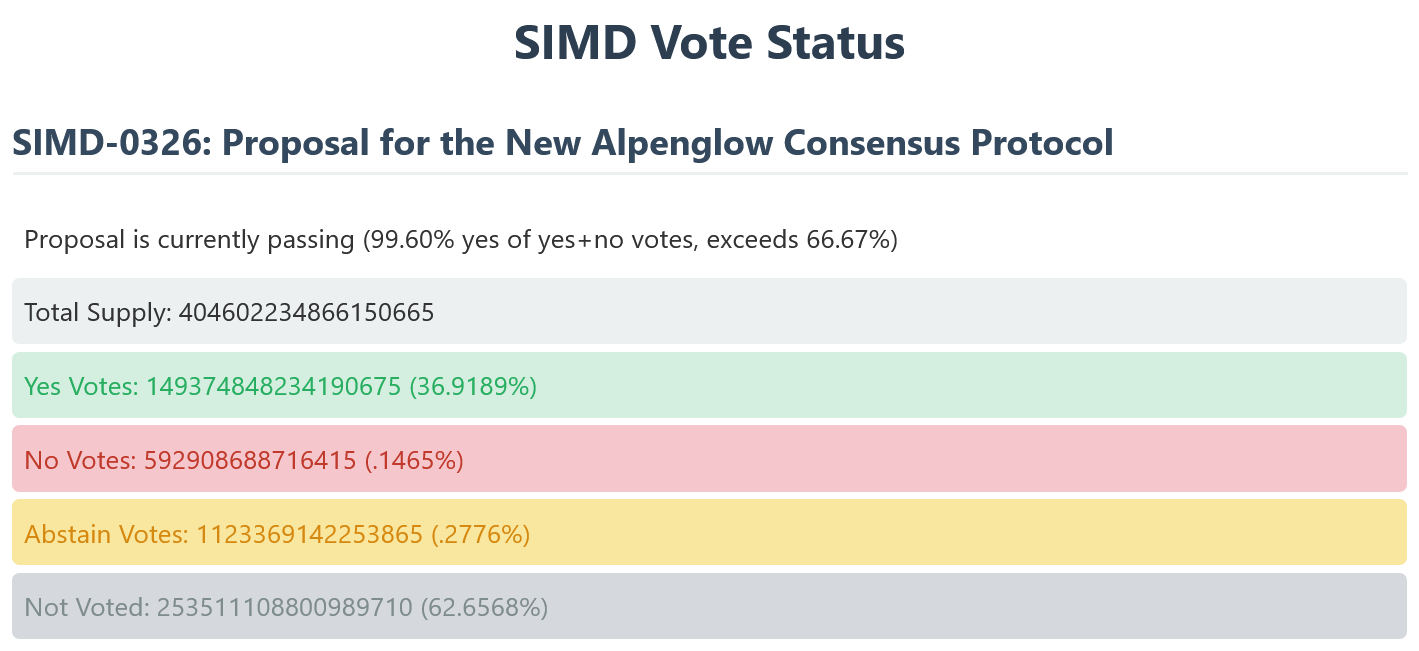Alpenglow is a Solana consensus upgrade that aims to cut transaction finality to about 150 milliseconds, potentially making Solana one of the fastest layer-1 blockchains. The proposal has received over 99% support so far and is poised to pass after quorum was reached.
-
99%+ of votes cast support Alpenglow, with quorum reached
-
Alpenglow targets ~150 ms transaction finality using Votor and Rotor components
-
If implemented, Solana could match or exceed Web2 response times and outpace many layer-1s
Alpenglow Solana upgrade targets 150ms finality; vote support >99% and quorum met — read the latest on timing and technical changes.
What is Solana’s Alpenglow proposal?
Alpenglow is a consensus upgrade for Solana designed to reduce transaction finality from ~12.8 seconds to roughly 150 milliseconds. The upgrade combines a new voting/finality layer (Votor) and a new block propagation protocol (Rotor) to deliver near-instant finality and Web2-like responsiveness.
How fast is Alpenglow expected to make transactions?
The white paper and release notes project a median finality of ~150 ms, roughly a near-100x improvement versus current finality figures. Staking Facilities data shows over 99.6% of votes cast are in favor. Solana block-epoch timelines indicate voting closes at epoch 842, expected to complete on Tuesday at 13:00 UTC.

Why would Alpenglow change Solana’s competitiveness?
Front-loaded, Alpenglow targets Web2-level responsiveness: a 150 ms median latency would let Solana compete with conventional internet services. That latency would place Solana ahead of many layer-1 blockchains, such as Sui (~400 ms finality), and potentially faster than typical Google search response times (~200 ms).
What are Alpenglow’s main technical components?
Votor replaces TowerBFT to process voting transactions and finalize blocks in a single round when 80% of stake participates, or two rounds at 60% responsiveness. Rotor replaces the multi-hop propagation (Turbine) with a single relayer layer to distribute blocks faster and more uniformly across validators.
Anza researchers Quentin Kniep, Kobi Sliwinski and Roger Wattenhofer said: “A median latency of 150 does not just mean that Solana is fast — it means Solana can compete with Web2 infrastructure in terms of responsiveness, potentially making blockchain technology viable for entirely new categories of applications that demand real-time performance.”
When will the vote conclude and what are the governance details?
Voting began on Aug. 21 and has achieved the 33% quorum threshold. With more than 99% of cast votes in favor, the proposal is expected to pass if voter participation remains consistent. Voting is scheduled to close at epoch 842, projected to finish on Tuesday at 13:00 UTC. Voting tallies referenced are from Staking Facilities and on-chain governance data.
Will Alpenglow fix network outages?
Alpenglow focuses on consensus finality and propagation speed, not on eliminating client-level vulnerabilities. The white paper states the upgrade alone won’t fully prevent outages tied to client bugs. Solana currently has one production-ready client (Agave), and client diversity is expected to improve with the planned Firedancer mainnet launch later this year.
Frequently Asked Questions
How much faster will Solana be after Alpenglow?
Alpenglow aims to reduce finality to ~150 ms from ~12.8 seconds, delivering about a 100x improvement in finality time and enabling near-instant confirmation for many application classes.
Who released the Alpenglow white paper?
The Alpenglow white paper was published by Anza, a Solana-native development firm spun out of Solana Labs. Key contributors include Quentin Kniep, Kobi Sliwinski and Roger Wattenhofer.
Does Alpenglow require a hard fork?
The governance proposal and upgrade path indicate a protocol-level change needing coordinated validator adoption; the vote and upgrade process follow Solana’s on-chain governance procedures and an activation epoch.
Key Takeaways
- Strong governance support: >99% of cast votes are in favor and quorum is met.
- Significant speed gains: Target finality is ~150 ms via Votor and Rotor.
- Operational considerations: Alpenglow does not eliminate client-based outage risks; Firedancer client aims to add diversification.
Conclusion
Alpenglow represents a major technical pivot for Solana, combining Votor and Rotor to aim for ~150 ms finality and Web2-like responsiveness. With overwhelming on-chain vote support and quorum achieved, the proposal is likely to pass; stakeholders should monitor activation epoch and client diversity developments closely.
Published by COINOTAG — Published: 2025-09-01 — Updated: 2025-09-01
1/ Rotor is Solana’s new block propagation protocol introduced in the Alpenglow upgrade. It’s a single layer of relayers that replaces Turbine’s multi-hop, delivering blocks faster and more uniformly across the network 🧵 pic.twitter.com/0KhpLuLe8u — Anza (@anza_xyz) August 13, 2025
Sources referenced in reporting: Staking Facilities, Solanabeach.io, Anza white paper, Firedancer client announcements. All source mentions are provided as plain text per publication policy.
